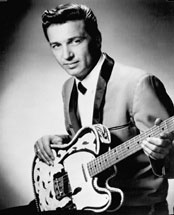White Lightning

Born in 1937 in Littlefield, Texas, Waylon Jennings grew up listening to folk songs and the music of seminal artists like Jimmie Rodgers, and later, to singers that ranged from Hank Williams, Ernest Tubb and Webb Pierce to B.B. King and Bobbie "Blue" Bland. He was a disc jockey at 14, and had already formed his own band at the age of 12, making guest appearances on local station KDAV’s "Sunday Party," where he met Holly in 1955. "Mainly what I learned from Buddy," Waylon says, "was an attitude. He loved music, and he taught me that it shouldn’t have any barriers to it." Holly produced Waylon’s first record and used him as a bass player--it was Waylon who gave up his seat to the big bopper on the plane that would crash, killing Holly and Ritchie Valens as well. By the early-to mid-’60s, Waylon was headlining a club called JD’s in Phoenix, putting out a sound that combined his "chicken-pickin’" Telecaster guitar style, his rough-edged, soulful vocal style and an eclectic repertoire that often borrowed from rock and rockabilly.
This combination was as popular as it was groundbreaking.
"We got long-haired people, lawyers, doctors, and all the cowboys," he says. Word got around, and after a short stint at Herb Alpert’s A&M Records, he was signed to RCA by Chet Atkins.
By 1968, he had hit the top five with "Only Daddy That’ll Walk The Line" and "Walk On Out Of My Mind," and a year later he would win a Grammy for a version of "MacArthur Park," recorded with the Kimberleys, and record several songs for the soundtrack album of Ned Kelly, a feature film starring Mick Jagger.
Still, the Nashville "system," in which producers often stamped their own ideas and formulas onto artists, was something Waylon was struggling against mightily. Jennings has recorded more than 60 albums and had 16 No. 1 country hits. He joined the Country Music Hall of Fame in October, but did not attend the induction ceremony, sending his son in his place to accept the honor.
Listen To Waylon Jennings - White Lightning



Comments